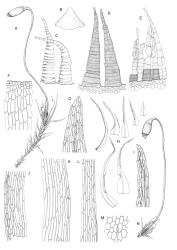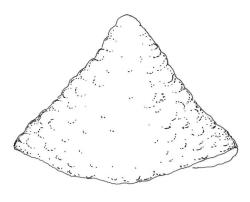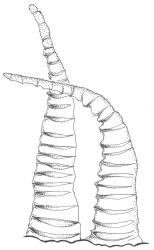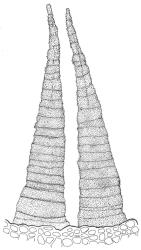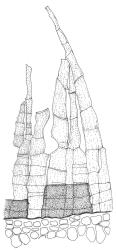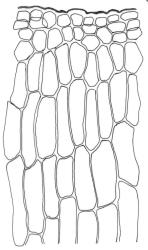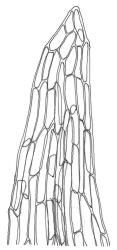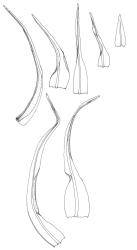- ≡ Bryum tenuifolium Hook.f. & Wilson, London J. Bot. 3: 546 (1844) nom. illeg., non Bryum tenuifolium Brid. 1801
- ≡ Webera tenuifolia A.Jaeger, Ber. Thätigk. St. Gallischen Naturwiss. Ges. 1873–1874: 137 (1875)
- = Bryum calcareum R.Br.bis, Trans. & Proc. New Zealand Inst. 31: 450 (1899)
- = Bryum walkeri R.Br.bis, Trans. & Proc. New Zealand Inst. 31: 457 (1899)
- = Bryum barrii R.Br.bis, Trans. & Proc. New Zealand Inst. 35: 334 (1903)
- = Bryum whittonii R.Br.bis, Trans. & Proc. New Zealand Inst. 35: 334 (1903)
Plants small, yellow-green, with a red stem, not or weakly lustrous when dry, usually forming loose turves or mixed with other mosses. Stems variable in length, 2 to at least 20 mm, unbranched, red, in cross-section with incrassate cortical cells and a central strand, beset with brown and nearly smooth rhizoids. Leaves sparse below, becoming more crowded and larger towards the shoot tip, erect-spreading, mostly homomallous, somewhat contorted when dry, lanceolate-subulate, entire or very weakly toothed at extreme apex, narrowly recurved in lower margins, not decurrent, mostly 1.8–3.2 × 0.25–4.0 mm (but smaller on lower stems); upper laminal cells obscure; mid laminal cells linear, firm-walled, mostly 60–105 × 5–7 µm, becoming broader and more oblong towards insertion. Costa extending to the leaf apex (but often appearing excurrent because of the obscurity of the upper lamina), in cross-section semi-circular and strongly protruding on the abaxial surface, with median guide cells and strong abaxial and weak adaxial stereid bands. Axillary gemmae nil.
Dioicous. Perichaetia terminal, the leaves differentiated only by size from the vegetative leaves. Perigonia inconspicuous, terminal, often overtopped by innovations (and then with multiple perigonia per shoot), with bracts shorter, broader, and more pigmented than adjacent vegetative leaves. Setae slender, flexuose, red, mostly (6–)9–14(–20) mm; capsules horizontal or nutant due to curvature of upper setae when moist, oblong-cylindric, pale red-brown, (1.0–)1.3–1.8 mm; annulus well-differentiated; operculum conic; exothecial cells oblong-hexagonal; stomata superficial. Exostome pale, the teeth narrowly bordered, very finely papillose on outer surface, strongly trabeculate on the inner surface; endostome with a rather low membrane and well-developed, perforate segments; cilia variable even within the same capsule, single, paired, or rudimentary, not or weakly nodose. Spores 14–18(–21) µm, nearly smooth.
Wilson 1854, pl. 85, fig. 5; Sainsbury 1955, pl. 39, fig. 3.
Pohlia tenuifolia is variable in stature, with the stems ranging from a few mm to over 20 mm in length, and setae that also vary in length. However, once the generic affinities of this plant are recognised, the lanceolate-subulate leaves that are widest at their insertion distinguish this plant from all other regional species of Pohlia, with the possible exception of P. ochii. The present species has leaves that are not decurrent, lacks axillary gemmae, and the plants are generally of smaller stature than P. ochii. Fruit are commonly produced in the present species (despite its dioicous sexuality), whereas in P. ochii they are extremely rare.
NI: N Auckland (Waipoua, Titirangi, Auckland City, Waiheke I.), S Auckland (Te Aroha, Te Akatea, Rotorua and vicinity), Gisborne (Lake Waikaremoana), Hawke’s Bay (Kiwi Station, Māhia Peninsula), Taranaki (Mt Messenger), Wellington (Manawatū Gorge); SI: Nelson, Marlborough (near Needles Point), Canterbury (Weka Pass, Banks Peninsula, South Branch of the Pareora River), Westland (Taramakau River), Otago (many localities in and near Dunedin, Waihola Hill, near Kaitangata). Martin (1949) recorded this species from St on the basis of a Robert Brown collection that has not been seen.
Endemic or austral. Shaw & Fife (1985) recorded the occurrence of this species in Chile and Brazil.
Occurring on bare, often vertical soil (clay, pumice, and sand) or porose rock (e.g. mudstone) in habitats such as stream banks, roadside drains, and damp rock faces. On the North I. documented from less than 100 m (Auckland Domain) to at least 610 m (Lake Waikaremoana), and on the South I. from near sea level (Whanganui Inlet, Nelson L.D.) to at least 260 m (Banks Peninsula). Bryum spp., including B. sauteri, Dicranella vaginata, Megaceros pellucidus, and Isotachis spp. are frequent associates. Pohlia tenuifolia is an inconspicuous and sparsely collected species and is probably more widespread than collections indicate.
The type of Bryum tenuifolium has been seen only using JSTOR. It is a Hooker collection from the Bay of Islands. The lectotype in BM is accompanied on the same sheet by numerous detailed pencil sketches by Wilson. These, plus the illustrations in Wilson (1854, pl. 85, fig. 5), leave no doubt that the Hooker collection is representative of Pohlia tenuifolia.
Bryum tenuifolium Hook.f. & Wilson was a later homonym at the time of its publication and hence illegitimate. Jaeger (1875) published a later combination in the genus Webera, which must be taken as the basionym. In the Flora Novae-Zelandiae, Wilson (1854) considered this species to be closely allied or possibly identical to the South American species now known as Pohlia humilis (Mont.) Broth. No material of this name has been available for comparison.
Wilson (1854, p. 83) also published Bryum tenuifolium var. exiguum, but did not clearly designate a type. This name is not considered further here.
Bryum calcareum, B. barrii, B. walkeri, and B. whittonii, all described by Robert Brown, were placed in the synonymy of P. tenuifolia by Dixon (1926). Of these names, only B. calcareum has type material present in N.Z. herbaria. There is no practical reason to question Dixon’s decisions.




